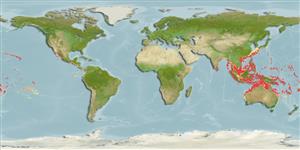Common names from other countries
Environment: milieu / climate zone / depth range / distribution range
Sinh thái học
Cùng sống ở rạn san hô; Mức độ sâu 36 - 200 m (Ref. 81020). Tropical
Widespread in the Indo-Pacific.
Length at first maturity / Bộ gần gũi / Khối lượng (Trọng lượng) / Age
Maturity: Lm ? range ? - ? cm Max length : 50.0 cm TL con đực/không giới tính; (Ref. 85218); common length : 32.0 cm TL con đực/không giới tính; (Ref. 122); Khối lượng cực đại được công bố: 1.6 kg (Ref. 122)
Mean live weight 1,200 to 1,600 g; body-wall thickness: 0.7 cm. Body cylindrical, arched dorsally (bivium) and flattened ventrally (trivium); calcareous disc of podia around 300 micrometer in diameter. Mouth ventral, surrounded by 20 small, short and yellowish tentacles. Anus nearly dorsal. Calcareous ring with large radial pieces and narrow interradials. Cuvierian tubules numerous and thick. Bivium yellow with brown band; trivium lighter; podia on bivium and trivium encircled by a characteristics brown spot. Spicules on ventral tegument with a variety of pseudo-rosettes and biscuit-like nodules; dorsal tegument with rosettes and a few rods; ventral podia with various rods; tentacles with rods, straight or slightly curved and very spiny.
May be harvested with other reef flat species, such as Bohadschia similis and Holothuria scabra, when they occur together, but the sticky Cuvierian tubules make the collection and processing disagreeable. Collected by hand at low tide, or by divers. Processed product is not distinguished from those of other Bohadschia species and is of little commercial value. Found in moderately shallow waters; mostly on coastal lagoons and inner reef flats; abundant in sandy-muddy sediments where it burrows most of the time (Ref. 122). Known to be nocturnally active (Ref. 85218). Population densities generally less than 0.02 per square meter (Ref. 122).
Conand, C. 1998. (Ref. 122)
IUCN Red List Status (Ref. 130435)
CITES status (Ref. 108899)
Not Evaluated
Not Evaluated
Threat to humans
Harmless
Human uses
Các nghề cá: buôn bán nhỏ
| FishSource | Biển chung quanh ta
Các công cụ
Các nguồn internet
Estimates based on models
Preferred temperature
(Ref.
115969): 18 - 28.1, mean 25.8 (based on 653 cells).
Vulnerability
Low to moderate vulnerability (30 of 100).
Price category
Unknown.
